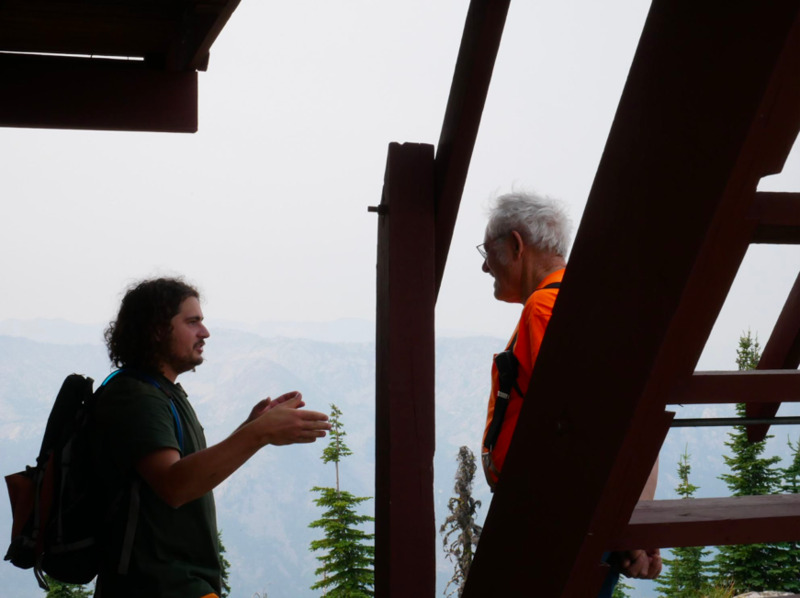Diablo Mountain Lookout





Built: 1926
Status: Staffed
Cabin: R-6
R-6

This cabin is a 15x15 foot design with a flat roof that extends over the deck to provide shade. Prior to its incorporation in 1953, the L-4 was the premier live-in cabin. R-6 cabins usually replaced L-4 cabins.
Other Resources:
National Lookout Historic Register
Rex's Fire Tower Page
Diablo Mountain Lookout is located in the Selway-Bitterroot Wilderness and is staffed by lookouts during peak fire season. This tower is populated by an interview with Bill Moore who has staffed lookouts for most of his life and now runs the volunteer fire lookout program at Diablo Mountain. Watch clips and his full interview for descriptions of his late father, Bud Moore’s, tenure with the Forest Service, a demonstration on how to use the Osborne Fire Finder, a detailed panoramic explanation of Diablo Mountain’s surrounding landscape, and why he has dedicated himself to preserving the tradition of lookouts, both structure and human.
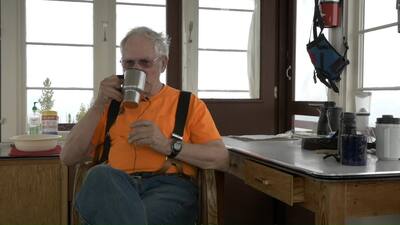
Diablo Mountain
-
Item 1 of 7
00:00:00:00 - 00:00:30:21
[Chris] Bill, could you just real quickly give us a kind of a walk through, maybe a 360-degree view here and what we’re looking at there?
[Bill] I’m chuckling about that because when I met ask him about staffing this lookout when we when we made the trip over and talked to Jack and me and my friend, he is hiring was what lookout do you want?
00:00:30:23 - 00:00:51:07
[Bill] I took Hidden Peak because it was the furthest away and my buddy took Diablo and I’ve always considered that I took over his lookout even though it’s like 50 years later, you know, I feel almost guilty. But when we talked about that, we were talking and the guy said, Man, it’s hard to teach people how to know how to know the country.
00:00:51:07 - 00:01:15:29
[Bill] And I said, I don’t think so. I can stand right here in his office and tell you most of the seen area from Diablo, just, you know, and if I can learn it, anybody can learn it. So I’m not sure how to put it. We’re sitting on a ridge between the Selway drainage and the Lochsa drainage. So that is Moose Crick goes down and runs into the Lochsa down around Lowell or somewhere there where it comes out.
00:01:16:02 - 00:01:37:20
[Bill] So this is the Lochsa runs down this way, and they end up in the same place in the the border between the two districts is right on this line. So if you wanna say, “Hey”, I want to go down and we went in Lochsa, it’s only two days down this way and you probably come out of.
00:01:37:21 - 00:01:58:00
[Bill] Powell Well, you’ll come out to that bridge they just wrapped, and this way it’s two weeks and you come out of Lowell. The this goes deeper in the wilderness, that one doesn’t. So you’ve got Big Sand Lakes up here in the fog, here in the smoke. You can just see the tail end of it about a mile long, has a sandbar and went in.
00:01:58:03 - 00:02:21:14
[Bill] Wonderful fishing. Great day, you could go in and spend the night and come back out eight miles. You come up over the ridgetop here. That’s Jeannette Mountain. You go down into East Moose Creek. It’s a little dead Elk Point right there, and there’s a little low one that’s footstool. Go down this way, that’s the gold Lakes. Behind them is Wahoo Point, Battle Creek Ridge, and some of that.
00:02:21:14 - 00:02:50:13
[Bill] This is all in what used to be the Nez Perce National Forest. On that side, it’s now the Clearwater-Nez. And as if this they’ve merged and you go on down here, you go around this corner where that smoke’s pretty heavy down there. That’s Elbow Bend between the hill. Been enough to lose corners and the huge natural cedar grove that was written up in the National Geographic in 1935, if you can believe that.
00:02:50:15 - 00:03:24:05
[Bill] But we’ll see then Ridge ridges going down like that. That’s the end of the Maple Ridge that’s Bell Point. Maple Ridge goes up along here. It’s not it’s generally the skyline bridge, but not always works its way up. There’s a little mountain range here called the Graves Peak Range. Right out. There’s Graves Peak ridges spur off and they go down on Saturday Ridge and they work their way down along the edge of the Lochsa between the locks in the Selway, uh, Bear Mountain lookouts down there.
00:03:24:08 - 00:03:48:19
[Bill] Your camp went over White Houses down under, off that ridge. Anyway, that’s Graves Peak. I knew the low. It’s real hard to see now. That big ridge in the smoke goes down. Ridges come kind of meet like that. That’s Savage Pass. And it’s where you drove into this country. You go down this way. That’s that road that was blocked off Pole Creek Road, that’s looking right at the mouth of Storm Creek.
00:03:48:21 - 00:04:09:00
[Bill] You go on up here, that big ridge goes this way it’s Hidden Ridge, Hidden Peak Lookout’s up there. I’m quite sure we can’t see it today. It’s named Hidden Peak for a reason. Big sand. And now you’re back up to the ridgetop pretty much, generally. There’s a lot more in here that sums up a lot of it.
- Title:
- The Diablo Mountain Scene Area
- Date Created:
- 2021-07-16
- Description:
- Bill Moore provides a detailed panoramic description of the Diablo Mountain view shed
- Subjects:
- Lochsa River Selway River Clearwater River Powell Ranger Station Diablo Peak Bill Moore Forest Service Volunteer lookouts Norman McClain Osborne Fire Finder Nez-Perce Clearwater National Forest Magruder Corridor Selway-Bitterroot Wilderness Smoke R-6
- Location:
- Selway-Bitterroot Wilderness
- Latitude:
- 46.29622
- Longitude:
- -114.61786
- Type:
- image;MovingImage
- Format:
- video/mp4
- Preferred Citation:
- "The Diablo Mountain Scene Area", Keeping Watch, Center for Digital Inquiry and Learning
- Reference Link:
- https://cdil.lib.uidaho.edu/keepingwatch/items/diablo-mountain.html#diablo-mountain001
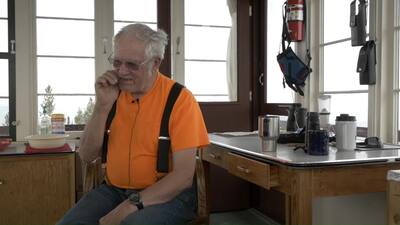
Diablo Mountain
-
Item 2 of 7
00:00:00:00 - 00:00:32:11
[Jack] Yeah, it does. And maybe you could give us a quick little demonstration on how an alidade works.
[Bill] Sure. It’s also called an Osborne Fire Finder what I tell my volunteers, is they’ll go, how are we going to do that? Well, this is not rocket science. They did not have rocket science in 1928 when they made this thing. So basically, any you guys work in machine shop or are Machinist?
00:00:32:13 - 00:00:59:21
[Bill] Yeah, they even nowadays they’re all electronics. But there’s a thing called the vernier caliper that you measure with and you line up a veneer line. So what you do basically is you see a smoke and the smokes are too nice to have something to shoot at. But there’s a little knob and there’s a smoke on that floating rail on top of it is actually smoked actually on the next novel over.
00:00:59:22 - 00:01:19:20
[Bill] But see, there’s a 1500 acre fire burning out in there just past its first range. So you put on what you see or smoke and then naturally you don’t you kind of don’t know where it is. But, you know, it’s under this tape because you’ve just shot it. These are horsetail hairs. That’s what you put on your alidade.
00:01:19:23 - 00:01:53:05
[Bill] And unfortunately, I had to find that over with coarser horsetail. Because it’s 35 for night shoot. But you do like that. Then you come around on the alidade and you read the veneer of what it is. In this case, it’s twenty, five, six, seven, eight, 28 degrees. And then there’s another one you can read that’ll give you the exact minutes, looks to be about 28 degrees, 15 minutes depending on how close it is and how long you’ve been doing it.
00:01:53:07 - 00:02:18:00
[Bill] Most of all time with ounces, they’ll go, Yeah, that’s twenty eight and a quarter. But somebody that’s just been taught how to will go that’s twenty eight and 14 minutes, you know. So anyhow, so now you look at that and you know that’s the angle of it that that’s part you write that down, then you read the terrain out to where you find out where where it is on the map.
00:02:18:00 - 00:02:36:07
[Bill] You know, it’s maybe three drainages over. And this is a contour map. And through the years you get to where you know what that is. So you look at it and then you put it in and then it goes across the section about where you think it is. And that section has a number. It’s in a township in a range.
00:02:36:07 - 00:03:09:06
[Bill] It’s the old way of surveying. So you look, pick one out there. Oh, it’s township 36, North 16 east section 15, northeast in the northwest corridor. So if you figure all that out, you’re within 40 acres. You write all that down and then you’ve got your thing and then you then you look at it and you say, Oh, that’s a South facing slope and it’s mature timber and the fires a third of the way down and you have all these things you can check off in a book.
00:03:09:09 - 00:03:48:04
[Bill] Well, this is a smoke report book. It looks like that. You go through that and then you you get all that done and you’ve got all this figured out. That’s when you change your plan. She’ll call it in, though. And from there, so that’s kind of a real fast way of going through it. But basically they actually and this is designed so you can do something in a way, you can move it back and forth to get around a stovepipe or you can pick it up and put it over here if you just need it for that.
00:03:48:04 - 00:04:13:02
[Bill] And then what we do is we buy a piece of plexiglass. Not plexiglass actually Lexan, because plexiglass is an acrylic and tends to shatter. But we put that on so that you could write with a grease pencil or something like that. And your map doesn’t say wear out and do all that. So I think that’s about it. You can do this.
00:04:13:02 - 00:04:27:15
[Bill] I mean, this is we can find a location if you want to. You can do all that and you’re happy to do that. So that’s that answer goes. And I’m sorry.
[Jack] That was great.
- Title:
- Bill Moore Demonstrates the Osborne Fire Finder
- Date Created:
- 2021-07-17
- Description:
- Bill Moore gives the Keeping Watch team a demo on the Osborne Fire Finder while locked in by smoke from the 2021 Lolo Complex Fires.
- Subjects:
- Lochsa River Selway River Clearwater River Powell Ranger Station Diablo Peak Bill Moore Forest Service Volunteer lookouts Norman McClain Osborne Fire Finder Nez-Perce Clearwater National Forest Magruder Corridor Selway-Bitterroot Wilderness Smoke R-6
- Location:
- Selway-Bitterroot Wilderness
- Latitude:
- 46.29622
- Longitude:
- -114.61786
- Type:
- image;MovingImage
- Format:
- video/mp4
- Preferred Citation:
- "Bill Moore Demonstrates the Osborne Fire Finder", Keeping Watch, Center for Digital Inquiry and Learning
- Reference Link:
- https://cdil.lib.uidaho.edu/keepingwatch/items/diablo-mountain.html#diablo-mountain002
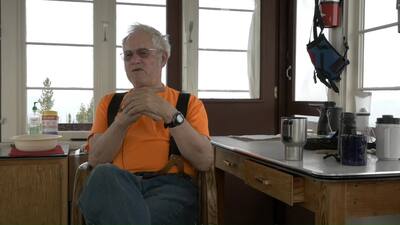
Diablo Mountain
-
Item 3 of 7
00:00:00:00 - 00:00:28:01
[Bill] I think his influence has been after he left the Forest Service, young folks, people like yourselves, who come and visit. And he they he could answer questions about why they did stuff clear back before World War Two. And it was like, you know, they didn’t just do anything kind of like throwing a dart at the phone booth.
00:00:28:01 - 00:00:48:11
[Bill] They had ideas and thoughts and were doing the best they knew and they could explain why they did it, how it turned out, were they right, how they’re doing it now, it is going to turn out, and stimulate a lot of thought. And I think because of that, he still has influence, because those young people are now decision makers. So.
- Title:
- The Influence that Bud Moore had on Forest Service Policy
- Date Created:
- 2021-07-17
- Description:
- Bill Moore discusses the influence his father, Bud Moore, has had on Forest Service policy.
- Subjects:
- Lochsa River Selway River Clearwater River Powell Ranger Station Diablo Peak Bill Moore Forest Service Volunteer lookouts Norman McClain Osborne Fire Finder Nez-Perce Clearwater National Forest Magruder Corridor Selway-Bitterroot Wilderness Smoke R-6
- Location:
- Selway-Bitterroot Wilderness
- Latitude:
- 46.29622
- Longitude:
- -114.61786
- Type:
- image;MovingImage
- Format:
- video/mp4
- Preferred Citation:
- "The Influence that Bud Moore had on Forest Service Policy", Keeping Watch, Center for Digital Inquiry and Learning
- Reference Link:
- https://cdil.lib.uidaho.edu/keepingwatch/items/diablo-mountain.html#diablo-mountain003
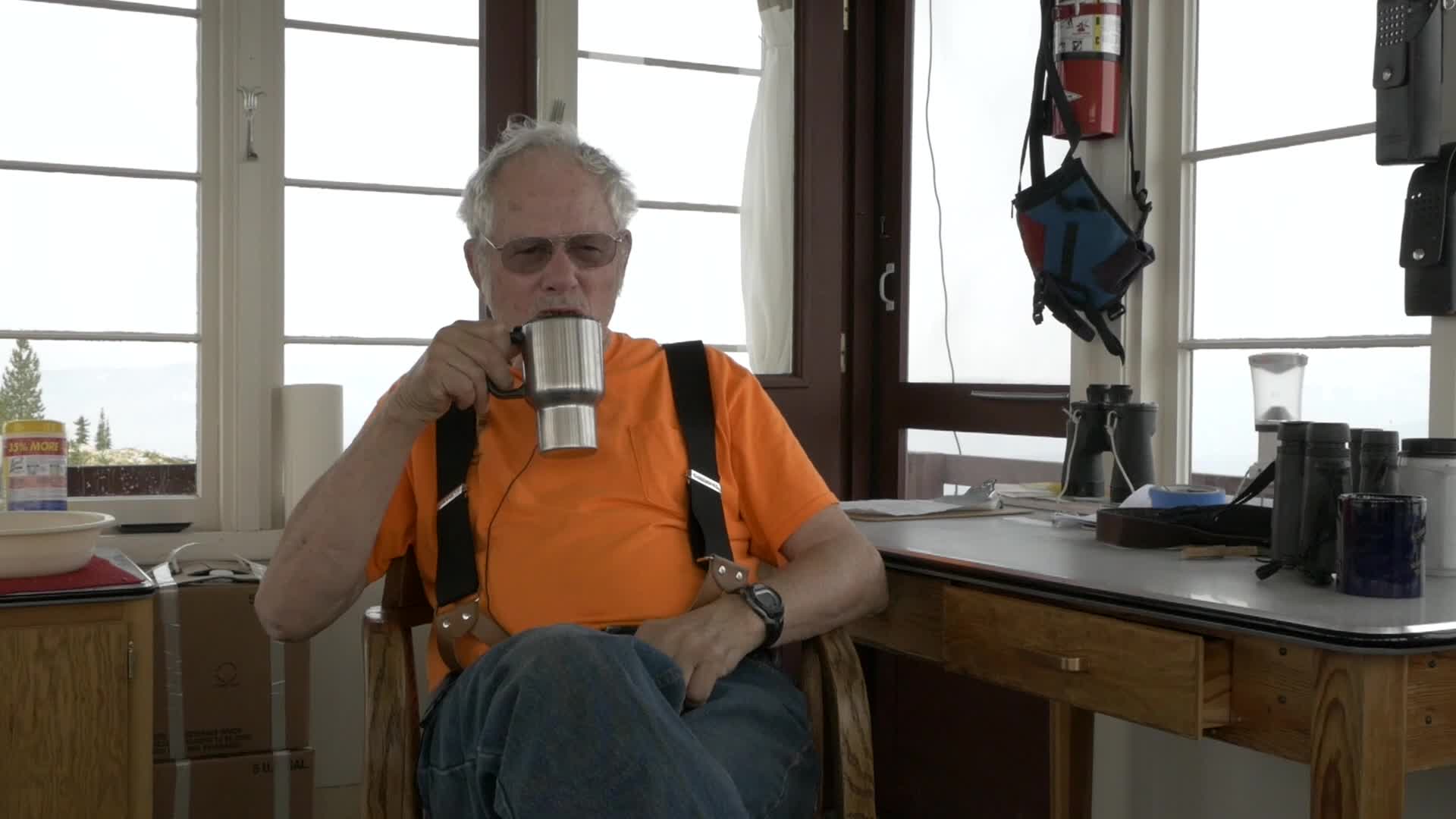
Diablo Mountain
-
Item 4 of 7
00:00:00:00 - 00:00:32:25
[Michael] That’s great. And thinking about that, do you think that with the kind of increasing obsolescence of the fire tower and the move towards new technologies to identify and spot fires, do you think that there’s anything that is lost in the transition away from the human staffed fire lookout.
[Bill] I’m hoping they’re not transitioning away.
00:00:32:28 - 00:01:08:24
[Bill] I, I, they have things like there’s a thing called Dragon Plot where you can you dispatcher can sit down and look at the camera and run the alidade. And he’s actually looking down through the camera at something and then he can plot the fire. It’s accurate, I think within about 5%. But of course to do that, you have to have the lookout with computer interface on it because it’s doing all kinds of algorithms to plot angle and whether you can see the base and where it’s at.
00:01:08:25 - 00:01:39:25
[Bill] And so but I think I don’t think that’s ever going to replace the man on the mountain. What would hurt the lookouts, probably initially more than anything, is aviation. Lookout used to be when you hired on the lookout, you were a lookout, smoke chaser if you were physically capable. And there were a lot of lookouts. And part of the reason was you were the initial attack.
00:01:39:27 - 00:02:05:22
[Bill] So you’d call you’d be in here and you’d go down there and there’d be a fire over on Hidden Ridge and you’d call it in with your phone and then the dispatch and say, well, you go hit it, see if you can get it, and off you’d go. And if you didn’t come back in four or five days and call in, they might send somebody out to see if you, you know, who did, did the fire get bigger, get it big, smaller, you know, but basically you were supposed to go put it out.
00:02:05:22 - 00:02:31:12
[Bill] That was your job. And the that created and the lookouts and a lot of overlapping scene area and stuff like that. They could see the same things a lot of, but a lot of that was just so you could get men, your lookout could get to the fire because you needed to be somewhat close. And that’s how they did it.
00:02:31:13 - 00:02:52:08
[Bill] Well, then along came aviation, and then one of two things happened. One, you came out with the smokejumpers so they could go on the fire. They didn’t lookout, didn’t have to hike out there and spend the day getting to the fire and still be by himself. They could put jumpers on it and that that way diminish that lead.
00:02:52:08 - 00:03:16:25
[Bill] And then with air patrol, air reconnaissance and later satellites and all that, it didn’t become as necessary to have overlapping scene area. If there were holes in it, you’d figure those out. Pretty soon you could look air patrol and always fly through where the lookouts couldn’t see that kind of thing. But I think they reached a balance where they kind of know that there has to be something going on.
00:03:16:25 - 00:03:51:17
[Bill] And I don’t have the perception that they’re trying to do that in the active movement to get away from lookouts. I know it’s hell to get one made, like in 1965 when Jack Puckett had this look out put up, he just wrote a purchase order to I think there was a place in Kalispell and one in Columbia Falls and one in Spokane said, send me an hour, six and enough blocks to put it on a ten foot blockhouse one each line item on a PO.
00:03:51:20 - 00:04:14:11
[Bill] And then they’d find a crew and generally old experience, old time hands, all kinds of stories about two young men that show up and get a job in the summer with one old worn out drill crew foreman. And then they build Bear Mountain Lookout. It’s a 50 foot tower and they do that all summer. That kind of thing. That’s how they did it.
00:04:14:18 - 00:04:43:01
[Bill] And nowadays, if this lookout burned down, they would re-engineer it from the bottom up, along with OSHA safety and blah, blah and historical interface. And, you know, it’d cost as much as to build the lookout just to engineering to build a lookout. And then they’d run into all kinds of issues with, you know, can we get the will we helicopter stuff in?
00:04:43:01 - 00:05:08:10
[Bill] Can they pack stuff in? And, you know, all that kind of stuff that, you know, it’s just a hassle. They build one [indistinguishable] Peak burned up in 2000 and they replaced that and it’s a total different design of a lookout and it was expensive to do that you know that but that’s today. So that’s the issue they have getting nowadays.
00:05:08:15 - 00:20:31:23
[Bill] So they look real hard at the cost analysis. For us, they don’t because the lookouts here and we take care of it, and we work really cheap and they like that. If you if you’re doing a good job, there’s no point in having volunteers up here if they are not either, by the way, that doesn’t accomplish much.
- Title:
- What is Lost in the Transition Away from the Human Staffed Fire Lookout?
- Date Created:
- 2021-07-16
- Description:
- Bill Moore discusses what is lost as the Forest Service and other agencies move away from lookout use.
- Subjects:
- systematic observation volunteer lookouts wilderness act of 1964
- Location:
- Selway-Bitterroot Wilderness
- Latitude:
- 46.29622
- Longitude:
- -114.61786
- Type:
- image;MovingImage
- Format:
- video/mp4
- Preferred Citation:
- "What is Lost in the Transition Away from the Human Staffed Fire Lookout?", Keeping Watch, Center for Digital Inquiry and Learning
- Reference Link:
- https://cdil.lib.uidaho.edu/keepingwatch/items/diablo-mountain.html#diablo-mountain004
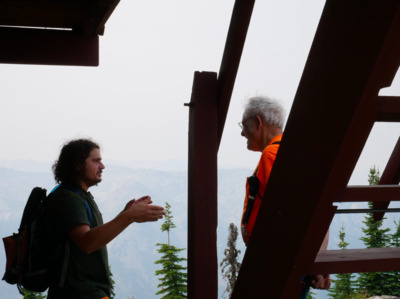
Diablo Mountain
-
Item 5 of 7
- Title:
- Michael Talks to Bill
- Date Created:
- 2021-07-17
- Description:
-
Michael Decker and Bill Moore on Diablo Peak
Photo by Chris Lamb - Subjects:
- Lochsa River Selway River Clearwater River Powell Ranger Station Diablo Peak Bill Moore Forest Service Volunteer lookouts Norman McClain Osborne Fire Finder Nez-Perce Clearwater National Forest Magruder Corridor Selway-Bitterroot Wilderness Smoke R-6
- Location:
- Selway-Bitterroot Wilderness
- Latitude:
- 46.29622
- Longitude:
- -114.61786
- Type:
- image
- Format:
- jpg
- Preferred Citation:
- "Michael Talks to Bill", Keeping Watch, Center for Digital Inquiry and Learning
- Reference Link:
- https://cdil.lib.uidaho.edu/keepingwatch/items/diablo-mountain.html#diablo-mountain005

Diablo Mountain
-
Item 6 of 7
- Title:
- Bill Moore - Full Interview
- Date Created:
- 2021-07-17
- Description:
- Full interview of Bill Moore
- Subjects:
- Lochsa River Selway River Clearwater River Powell Ranger Station Diablo Peak Bill Moore Forest Service Volunteer lookouts Norman McClain Osborne Fire Finder Nez-Perce Clearwater National Forest Magruder Corridor Selway-Bitterroot Wilderness Smoke R-6 the wilderness act of 1964
- Location:
- Selway-Bitterroot Wilderness
- Latitude:
- 46.29622
- Longitude:
- -114.61786
- Type:
- image;MovingImage
- Format:
- video/youtube
- Preferred Citation:
- "Bill Moore - Full Interview", Keeping Watch, Center for Digital Inquiry and Learning
- Reference Link:
- https://cdil.lib.uidaho.edu/keepingwatch/items/diablo-mountain.html#diablo-mountain006
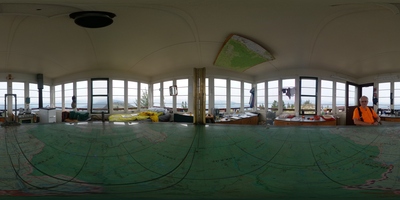
Diablo Mountain
-
Item 7 of 7
- Title:
- Diablo Lookout 360 Degree Image
- Date Created:
- 2021-07-16
- Description:
- Panoramic image of the interior of Diablo Mountain lookout
- Subjects:
- osborne fire finder horse hair sight rotating sight ring seen area systematic observation township range r-6
- Location:
- Selway-Bitterroot Wilderness
- Latitude:
- 46.29622
- Longitude:
- -114.61786
- Type:
- image; panorama
- Format:
- image/jpeg
- Preferred Citation:
- "Diablo Lookout 360 Degree Image", Keeping Watch, Center for Digital Inquiry and Learning
- Reference Link:
- https://cdil.lib.uidaho.edu/keepingwatch/items/diablo-mountain.html#diablo-mountain007

